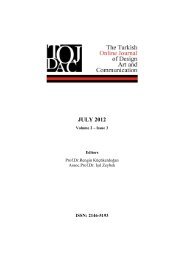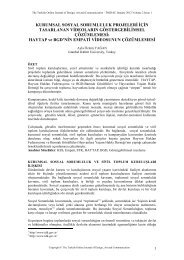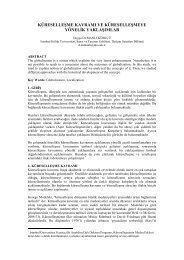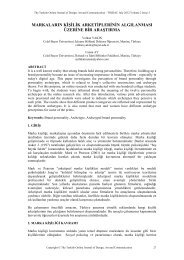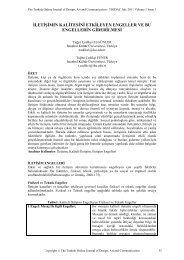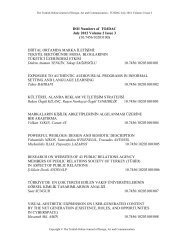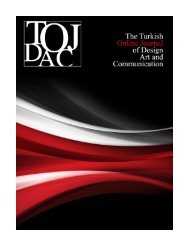aprıl 2012 - tojdac.org
aprıl 2012 - tojdac.org
aprıl 2012 - tojdac.org
Create successful ePaper yourself
Turn your PDF publications into a flip-book with our unique Google optimized e-Paper software.
The Turkish Online Journal of Design, Art and Communication - TOJDAC April <strong>2012</strong> Volume 2 Issue 2<br />
from which to choose. Experimentation can be done on the set with lighting and other smoke<br />
and debris elements to blend the subjects together. A good example of this is a shot from The<br />
Fugitive (1993), in which dust and debris shot from an air cannon landed on top of Harrison<br />
Ford just as a train crashed into the hillside. This was done using a front projection system<br />
that tied in all of the dust and debris on top of Harrison with the plate for integration of the<br />
elements [15] Today, front projection has virtually disappeared. And while film-based rear<br />
projection is almost extinct as well, the process has made a significant comeback in digital<br />
production, in features as well as in television and commercials. For example, the movie Get<br />
Smart (2008) used digital rear projection for dozens of shots.<br />
4.4. Miniatures vs. Digital Models<br />
The first miniature ever captured on film appears to have been the recreation in 1897 of a<br />
naval battle during the Greco-Turkish War by the French film pioneer Ge<strong>org</strong>es Melies. It<br />
didn’t look very convincing by our standards, but miniatures have been an invaluable adjunct<br />
to live-action photography ever since. We can use miniatures in various combinations with<br />
live action or digital elements, and like other visual effects, we use miniatures when it’s<br />
impossible to use the real thing because it’s too expensive to film, is inaccessible, or doesn’t<br />
exist in the first place. Miniatures can be either hanging in front of the camera and the live<br />
action in the back ground, or stand alone miniatures as in plane crashes and explosions or<br />
miniatures with composited elements This technique involves the compositing of a miniature<br />
either with a live-action plate, a matte painting, or some form of computer-generated<br />
background that will supplement the miniature photography. Compositing miniatures with<br />
other elements is probably the most common use of miniatures, and certainly one of the most<br />
widely used visual effects techniques. The Lord of the Rings and Harry Potter trilogies, for<br />
example, were full of such shots.<br />
In recent years, miniatures have run into stiff competition from computer-generated<br />
environments and objects. The trend began mainly in television and gradually spread into<br />
feature films as software became more sophisticated, allowing digital artists to model, texture,<br />
and paint their creations in the computer faster and cheaper than their colleagues who were<br />
building physical models. That trend appears to have stabilized as filmmakers found that each<br />
technique has its merits, depending on the requirements of a particular project. A good<br />
example of this is the 2004 film The Aviator, a film starring Leonardo Di Caprio in the role of<br />
famed aviation pioneer Howard Hughes. That film seamlessly blended both physical and CG<br />
models. The re-creation of an aerial dogfight near the beginning of the film was realized<br />
almost entirely with CG models, while later sequences — including a spectacular sequence of<br />
Hughes crashing an experimental aircraft into a Beverly Hills neighborhood — were<br />
accomplished entirely with physical models. [16]<br />
4.5. Blue Screen Photography<br />
Blue screen process is one of the survivals techniques; it was used in conventional VFX and<br />
still in use with digital cinema. Blue screen was used as early as the silent period for<br />
generating high-quality composites on black-and-white film using the Dunning Pomeroy<br />
process. As the years progressed and color film came into being, many effects artists adapted<br />
the idea of using a blue screen to isolate an element photographically to create color<br />
composites. One of the early examples of the process was that developed by Lawrence Butler<br />
for Alexander Korda's The Thief of Baghdad in 1940. The color blue was first used for the<br />
simple reason that there is very little blue in skin tones. The blue wavelength can be isolated<br />
while still getting a fairly acceptable color rendition for faces.<br />
The process made use of black-and-white separations. A separation is a black-and-white film<br />
that contains only one of the color components. It is made by placing the color negative in<br />
contact with black-and-white film and exposing it with a primary color. There were many<br />
problems with this method Some development were made to enhance the quality of the blue<br />
screen mattes. In the mid-1950s that a brilliant inventor named Petro Vlahos perfected the<br />
Copyright © The Turkish Online Journal of Design, Art and Communication 119



